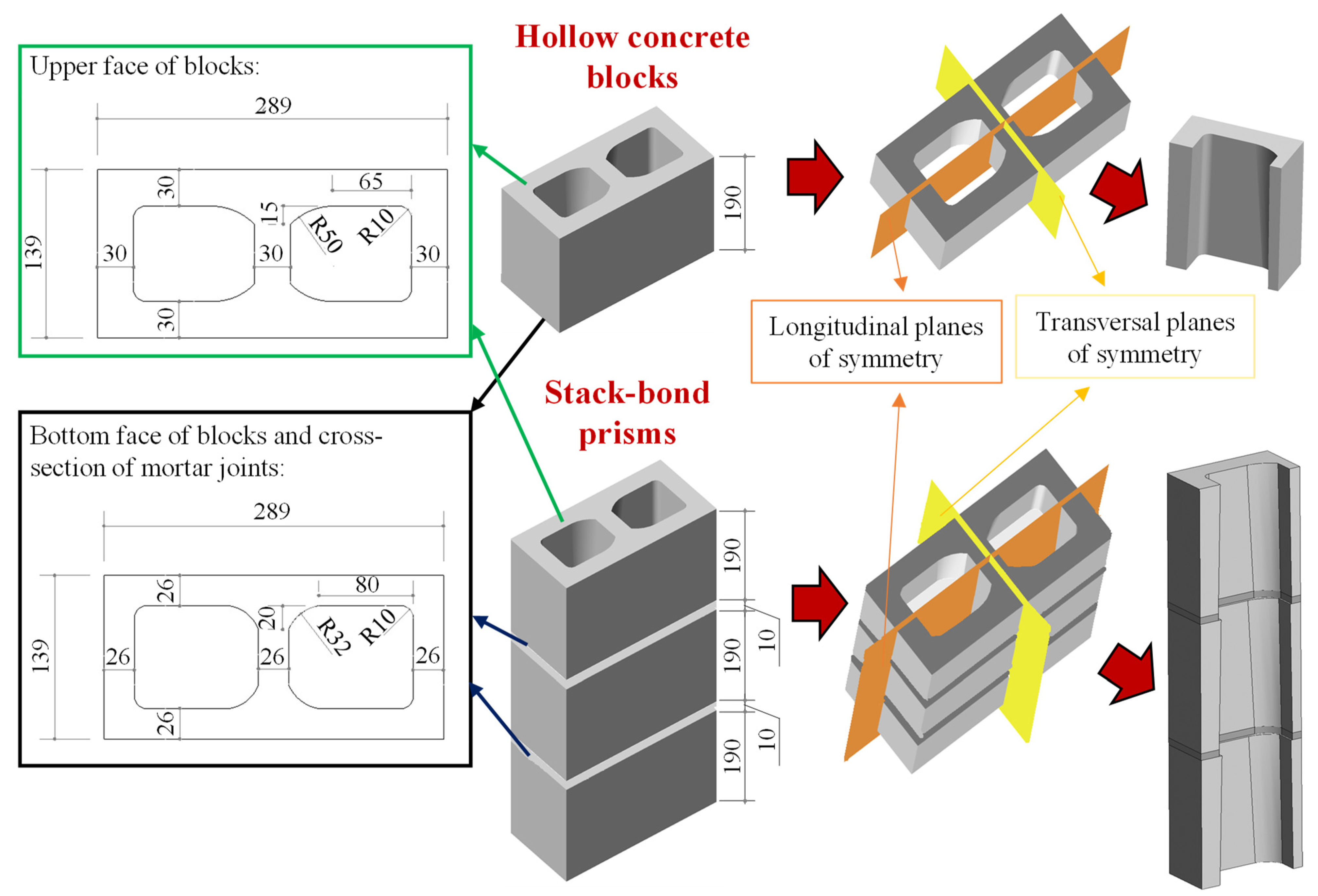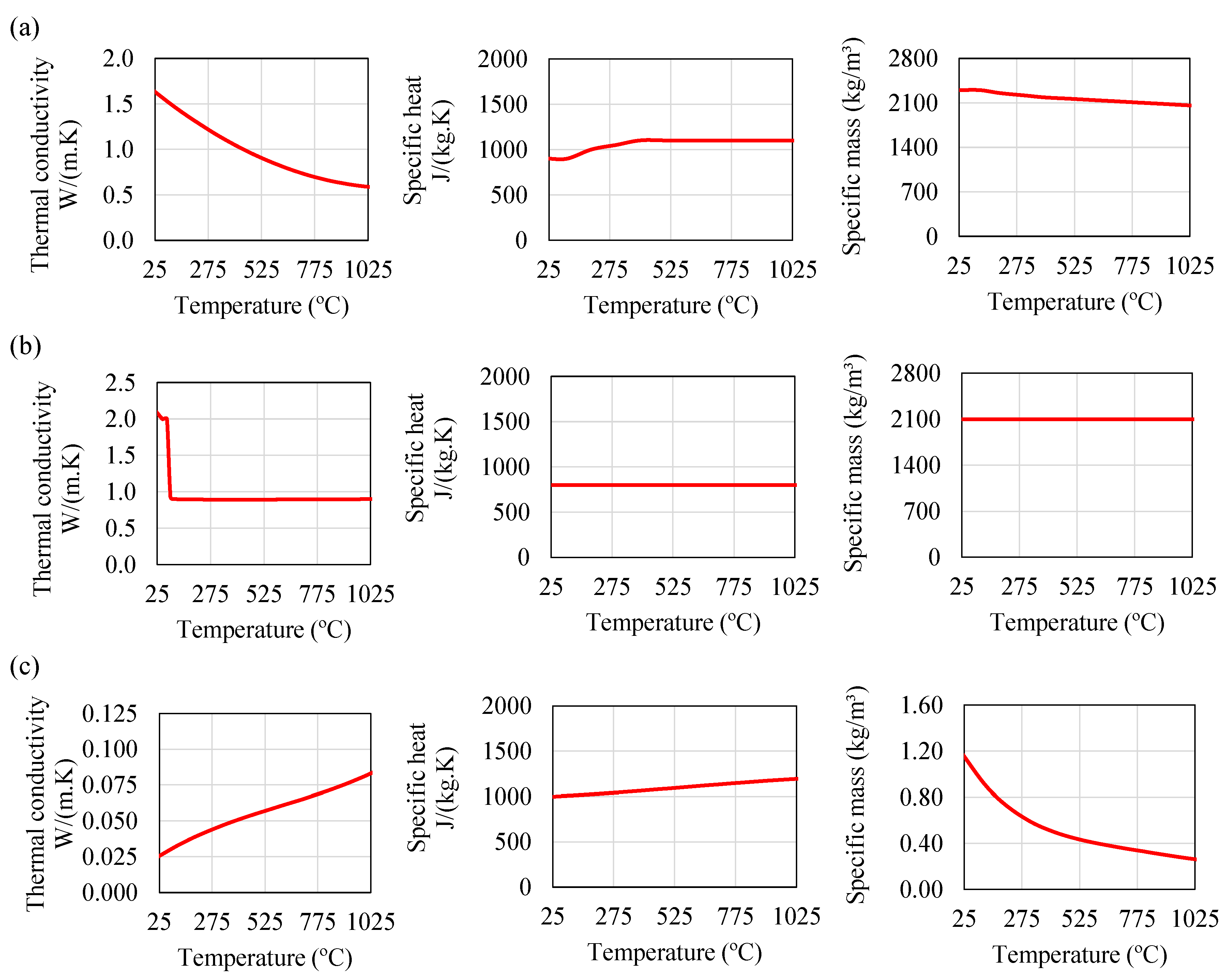Thermal Analysis of Concrete Blocks and Stack-Bond Prisms under Different Boundary Conditions
Abstract
1. Introduction
2. Materials and Methods
2.1. Experimental Analysis
2.2. Numerical Analysis
3. Results and Discussion
3.1. BC1-300 and BC2-300 Thermal Analyses
3.2. PC1-300, PC2-300, PC1-600 and PC2-600 Thermal Analyses
4. Conclusions
Supplementary Materials
Author Contributions
Funding
Data Availability Statement
Acknowledgments
Conflicts of Interest
References
- Daware, A.; Naser, M.Z. Fire Performance of Masonry under Various Testing Methods. Constr. Build. Mater. 2021, 289, 123183. [Google Scholar] [CrossRef]
- Yassin, M.; Adnan, S.; Shahidan, S.; Ali, N.; Kamarulzaman, N.; Roni, N. Strength and Physical Properties of Sustainable Concrete Masonry at Elevated Temperature: A Review. Malays. Constr. Res. J. 2018, 4, 45–55. [Google Scholar]
- Russo, S.; Sciarretta, F. Masonry Exposed to High Temperatures: Mechanical Behaviour and Properties—An Overview. Fire Saf. J. 2013, 55, 69–86. [Google Scholar] [CrossRef]
- Assis, E.; Neto, J. Analysis of Heat Transfer Mechanisms on Hollow Concrete Masonry Units under Standardized Fire Conditions. In Proceedings of the XLI Ibero-Latin-American Congress on Computational Methods in Engineering (CILAMCE), Foz do Iguaçu, Brazil, 16–19 November 2020. [Google Scholar]
- Nalon, G.; Ribeiro, J.; Pedroti, L.; Silva, R.; Araújo, E.; Santos, R.; Lima, G. Review of Recent Progress on the Effects of High Temperatures on the Mechanical Behavior of Masonry Prisms. Infrastructures 2023, 8, 112. [Google Scholar] [CrossRef]
- Leal, C. Structural Masonry with Concrete Units: Residual Mechanical Properties of Mortars, Grouts and Prisms Submitted to High Temperatures. Ph.D. Thesis, Universidade Federal de São Carlos, São Carlos, Brazil, 2023. (In Portuguese). [Google Scholar]
- Kiran, T.; Anand, N.; Andrushia, A.D.; Kodur, V.; Mathews, M.E.; Arulraj, G.P. Performance of Clay Masonry Prisms with Light Weight Plaster Exposed to Standard Fire Exposure. Fire Mater. 2022, 47, 99–119. [Google Scholar] [CrossRef]
- ISO 834; Fire-Resistance Tests—Elements of Building Construction. ISO: Geneva, Switzerland, 1999.
- Gao, S.; Hao, D.; Zhu, Y.; Wang, Z. Compression and Shear Properties of Unreinforced Masonry Structures Reinforced by ECC/HECC Subjected to High Temperatures. KSCE J. Civ. Eng. 2023, 27, 751–768. [Google Scholar] [CrossRef]
- Bittencourt, B.; Antunes, E. Mechanical Behavior of Grouted Prisms Exposed to High Temperatures: Aid to Future Standardization. Repositório UNESC 2019, 1, 1–18. (In Portuguese) [Google Scholar]
- Leal, D.F.; Dupim, R.H.; Munaiar Neto, J.; Corrêa, M.R.S. Experimental Investigation on Structural Concrete Masonry in Fire: Emphasis on the Thermal Behavior and Residual Strength. Rev. IBRACON Estrut. Mater. 2021, 14, 1–16. [Google Scholar] [CrossRef]
- Neto, J. Estudo Experimental Do Comportamento de Elementos de Alvenaria Estrutural Com Blocos Cerâmicos Em Situação de Incêndio. Master’s Thesis, University of São Paulo, São Carlos, Brazil, 2020. [Google Scholar]
- Dupim, R. Resistência Residual de Compressão de Blocos, Prismas e Pequenas Paredes de Alvenaria Estrutural de Blocos de Concreto Submetidos à Situação de Incêndio. Master’s Thesis, University of São Paulo, São Carlos, Brazil, 2019. [Google Scholar]
- Torregrosa, M.E.M.; Diez, J.C. Heat Transfer Mechanism and Thermomechanical Analysis of Masonry Structures (Mortars and Bricks) Subjected to High Temperatures. In Reactions and Mechanisms in Thermal Analysis of Advanced Materials; John Wiley & Sons, Inc.: Hoboken, NJ, USA, 2015; pp. 437–466. [Google Scholar]
- Prakash, P.R.; Azenha, M.; Pereira, J.M.; Lourenço, P.B. Finite Element Based Micro Modelling of Masonry Walls Subjected to Fire Exposure: Framework Validation and Structural Implications. Eng. Struct. 2020, 213, 110545. [Google Scholar] [CrossRef]
- Sciarretta, F. Modeling of Mechanical Damage in Traditional Brickwork Walls after Fire Exposure. Adv. Mat. Res. 2014, 919–921, 495–499. [Google Scholar] [CrossRef]
- Oliveira, R.G.; Rodrigues, J.P.C.; Miguel Pereira, J.; Lourenço, P.B.; Lopes, R.F.R. Experimental and Numerical Analysis on the Structural Fire Behaviour of Three-Cell Hollowed Concrete Masonry Walls. Eng. Struct. 2021, 228, 111439. [Google Scholar] [CrossRef]
- Russo, S.; Sciarretta, F. Numeric Research on the Mechanical Properties of Different Masonry Units during and after Fire. In Brick and Block Masonry—Trends, Innovations and Challenges; Taylor & Francis Group: London, UK, 2016; pp. 999–1005. [Google Scholar]
- Bosnjak, J.; Gambarelli, S.; Sharma, A.; Meskovic, A. Experimental and Numerical Studies on Masonry after Exposure to Elevated Temperatures. Otto-Graf-J. 2019, 18, 41–52. [Google Scholar] [CrossRef]
- Bošnjak, J.; Gambarelli, S.; Sharma, A.; Mešković, A. Experimental and Numerical Studies on Masonry after Exposure to Elevated Temperatures. Constr. Build. Mater. 2020, 230, 116926. [Google Scholar] [CrossRef]
- Rodovalho, F.S.; Corrêa, M.R.S. Thermal Simulation of Prisms with Concrete Blocks in a Fire Situation. IBRACON Struct. Mater. J. 2019, 12, 638–657. [Google Scholar] [CrossRef]
- da Silva Rodovalho, F.; Corrêa, M.R.S.; Munaiar Neto, J. Simulação Termomecânica de Prismas Com Blocos de Concreto Em Situação de Incêndio. Rev. Matéria 2020, 25. [Google Scholar] [CrossRef]
- da Costa Quispe, A.P.; Rodríguez, R.Q.; Lübeck, A.; de Lima, R.C.A. Análise Comparativa Numérica Da Transferência de Calor Em Prismas de Alvenaria Em Situação de Incêndio. Ambiente Construído 2023, 23, 113–129. [Google Scholar] [CrossRef]
- ABNT NBR 12118; Hollow Concrete Blocks for Concrete Masonry—Test Methods. Associação Brasileira de Normas Técnicas: Rio de Janeiro, Brazil, 2013.
- ASTM C140/C140M; Standard Test Methods for Sampling and Testing Concrete Masonry Units and Related Units. ASTM: West Conshohocken, PA, USA, 2020.
- Medeiros, W.A.; Parsekian, G.A.; Moreno, A.L. Test Methodology for Determining the Mechanical Properties of Concrete Blocks at High Temperatures. Mater. Struct. 2022, 55, 61. [Google Scholar] [CrossRef]
- Ribeiro, J.C.L.; Fakury, R.H.; Barbosa de Las Casas, E. Eurocode Structural Fire Design and Its Application for Composite Circular Hollow Section Columns. J. Braz. Soc. Mech. Sci. Eng. 2008, 30, 39–46. [Google Scholar] [CrossRef]
- Ribeiro, J.C.L.; Fakury, R.H.; Barbosa de Las Casas, E. Desenvolvimento de Um Sistema via Método Dos Elementos Finitos Para Simulação Do Comportamento de Elementos Estruturais de Aço e Mistos Em Situação de Incêndio. Rev. Sul-Am. Eng. Estrut. 2011, 8, 20–33. [Google Scholar] [CrossRef]
- Ribeiro, J.C.L.; Fakury, R.H.; Barbosa de Las Casas, E. Determinação Da Intensidade de Um Incêndio Natural Por Meio Do Deslocamento Plástico Em Vigas de Aço Após o Resfriamento. In Proceedings of the Iberian-Latin American Congress in Fire Safety, Coimbra, Portugal, 29 May–1 June 2013. [Google Scholar]
- Ribeiro, J.C.L.R. Development and Application of Computational System for Finite Element Method Simulation of the Behavior of Steel and Composite Structures in Fire Conditions. Ph.D. Thesis, Universidade Federal de Minas Gerais, Belo Horizonte, Brazil, 2009. (In Portuguese). [Google Scholar]
- Gerken, A. Thermal Protection Materials for Low-Cost Steel-Structured Construction Systems. Master’s Thesis, Universidade Federal de Minas Gerais, Belo Horizonte, Brazil, 2007. (In Portuguese). [Google Scholar]
- Castro, G. A General Calculation Method for the Verification of Concrete Structures in Fire Situations. Master’s Thesis, Universidade Federal de Minas Gerais, Belo Horizonte, Brazil, 2005. (In Portuguese). [Google Scholar]
- Costa, R. Behavior of Composite Columns Filled with High-Performance Refractory Concrete at Ambient Temperature and in Fire Conditions. Master’s Thesis, Universidade Federal de Minas Gerais, Belo Horizonte, Brazil, 2005. (In Portuguese). [Google Scholar]
- Moreira, A. Verification of Rectangular Reinforced Concrete Sections Subjected to Combined Oblique Bending in Fire Conditions. Master’s Thesis, Universidade Federal de Minas Gerais, Belo Horizonte, Brazil, 2013. (In Portuguese). [Google Scholar]
- CIMNE GiD—International Center for Numerical Methods in Engineering 2004. Available online: https://www.gidsimulation.com (accessed on 29 December 2023).
- EN 1991-1-2; Eurocode 1: Actions on Structures—Part 1–2: General Actions—Actions on Structures Exposed to Fire. CEN: Brussels, Belgium, 2002.
- CEN; Eurocode 4: Design of Composite Steel and Concrete Structures—Part 1–2: General Rules—Structural Fire Design. CEN: Brussels, Belgium, 2005.
- EN 1996-1-2; Eurocode 6—Design of Masonry Structures—Part 1–2: General Rules—Structural Fire Design. CEN: Brussels, Belgium, 2010.
- Kim, S.H.; Huh, H. Optimum Finite Element for Simulation of Elasto-Plastic Bending of Sheet Metal. Met. Mater. 1998, 4, 685–694. [Google Scholar] [CrossRef]
- Ben Bettaieb, A.; Velosa de Sena, J.L.; Alves de Sousa, R.J.; Valente, R.A.F.; Habraken, A.M.; Duchêne, L. On the Comparison of Two Solid-Shell Formulations Based on in-Plane Reduced and Full Integration Schemes in Linear and Non-Linear Applications. Finite Elem. Anal. Des. 2015, 107, 44–59. [Google Scholar] [CrossRef]
- Jain, M.; Kapuria, S. Time-Domain Spectral Finite Element Based on Third-Order Theory for Efficient Modelling of Guided Wave Propagation in Beams and Panels. Acta Mech. 2022, 233, 1187–1212. [Google Scholar] [CrossRef]
- CEN; Eurocode 2: Design of Concrete Structures—Part 1–2: General Rules—Structural Fire Design. CEN: Brussels, Belgium, 2004.
- da Silva Rodovalho, F.; de Souza Simões, Y.; Correa, M.R.S. Análise Térmica de Alvenaria Estrutural Em Situação de Incêndio: Um Estudo Do Gradiente Térmico. In Proceedings of the XXXVIII Iberian-Latin American Congress on Computational Methods in Engineering, Florianópolis, Brazil, 5–8 November 2017. [Google Scholar]
- Incropera, F.; DeWitt, D. Fundamentals of Heat and Mass Transfer, 3rd ed.; Editora Guanabara Koogan S. A.: Rio de Janeiro, Brazil, 1992. [Google Scholar]









| Parameter | Average | SD |
|---|---|---|
| Length (mm) | 289.3 | 0.3 |
| Width (mm) | 138.8 | 0.4 |
| Height (mm) | 189.9 | 0.8 |
| Thickness of the face shells (mm) | 26.3 | 0.3 |
| Thickness of the webs (mm) | 26.4 | 0.2 |
| α value (%) | 57.8 | 0.4 |
| Net area compressive strength (MPa) | 17.4 | 1.1 |
| Water absorption (%) | 6.0 | 0.4 |
| Density (g/cm³) | 2.16 | 0.03 |
| Analysis | Model Composition | Boundary Conditions | Maximum Exposure Temperature |
|---|---|---|---|
| BC1-300 | B + AM | BC1 | 300 °C |
| BC2-300 | B | BC2 | |
| PC1-300 | P + AM | PC1 | |
| PC2-300 | P | PC2 | |
| PC1-600 | P + AM | PC1 | 600 °C |
| PC2-600 | P | PC2 |
Disclaimer/Publisher’s Note: The statements, opinions and data contained in all publications are solely those of the individual author(s) and contributor(s) and not of MDPI and/or the editor(s). MDPI and/or the editor(s) disclaim responsibility for any injury to people or property resulting from any ideas, methods, instructions or products referred to in the content. |
© 2024 by the authors. Licensee MDPI, Basel, Switzerland. This article is an open access article distributed under the terms and conditions of the Creative Commons Attribution (CC BY) license (https://creativecommons.org/licenses/by/4.0/).
Share and Cite
Nalon, G.H.; Ribeiro, J.C.L.; Pedroti, L.G.; da Silva, R.M.; de Araújo, E.N.D. Thermal Analysis of Concrete Blocks and Stack-Bond Prisms under Different Boundary Conditions. Constr. Mater. 2024, 4, 58-71. https://doi.org/10.3390/constrmater4010004
Nalon GH, Ribeiro JCL, Pedroti LG, da Silva RM, de Araújo END. Thermal Analysis of Concrete Blocks and Stack-Bond Prisms under Different Boundary Conditions. Construction Materials. 2024; 4(1):58-71. https://doi.org/10.3390/constrmater4010004
Chicago/Turabian StyleNalon, Gustavo Henrique, José Carlos Lopes Ribeiro, Leonardo Gonçalves Pedroti, Roberto Marcio da Silva, and Eduardo Nery Duarte de Araújo. 2024. "Thermal Analysis of Concrete Blocks and Stack-Bond Prisms under Different Boundary Conditions" Construction Materials 4, no. 1: 58-71. https://doi.org/10.3390/constrmater4010004
APA StyleNalon, G. H., Ribeiro, J. C. L., Pedroti, L. G., da Silva, R. M., & de Araújo, E. N. D. (2024). Thermal Analysis of Concrete Blocks and Stack-Bond Prisms under Different Boundary Conditions. Construction Materials, 4(1), 58-71. https://doi.org/10.3390/constrmater4010004






